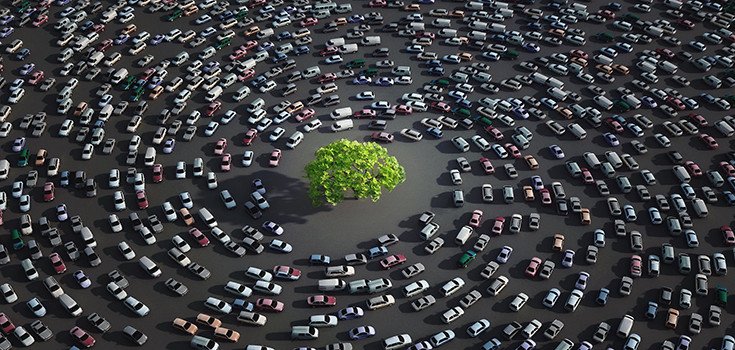4 Ways Our Congested Roadways Hurt the Environment

Just about everyone with a driver’s license has been stuck in traffic at least once. Whether it’s the usual rush-hour slowdown or a delay caused by construction, sitting in traffic is a frustrating experience. However, it’s more than a personal nuisance.
Clogged highways make cars burn more gasoline than they would at normal driving speeds. This has many negative repercussions for the environment, from the hazards of oil production to the many pollutants found in vehicle exhaust. Read on to learn more about 4 ways our congested roadways hurt the environment.
1. Vehicles Burn More Fuel in Slow Traffic

It may seem counterintuitive, but cars consume more gasoline going 10 or 20 mph than at higher speeds like 40 to 60 mph. For example, in Miami, one of the country’s worst congestion spots, drivers wasted an average of 24 gallons of fuel a year due to slow traffic.
Now imagine three or four lanes of cars, all stopped or barely moving, and the backup reaching as far as the eye can see. Suddenly 24 gallons multiplies into 2,400, 24,000, or 240,000 gallons of excess fuel. In addition to the economic cost of all that gas, there is a significant environmental cost. Both the production and consumption of gasoline are harmful to our air quality and other natural resources.
2. Oil Production Takes Its Toll on the Environment

Oil spills are the most dramatic way oil production harms the environment. While rare, their effects are far-reaching. The Gulf Coast is still cleaning up damage from the 2010 Deepwater Horizon spill, which dumped 3 million gallons of oil into the water and along the coastline. Offshore drilling is known to be riskier than extracting oil on land, but our dependence on this finite fossil fuel pushes us to collect it in increasingly dangerous ways.
Even in normal day-to-day oil production, environmental harm is a regular side effect. The metal pipes which carry oil from its source to refineries can become degraded and leak oil into the water and land surrounding the pipes. Air pollution from dust and fires also results from drilling. All of those gallons of wasted fuel caused by traffic congestion increase our demand for oil, as well as damage to the Earth.
Read: How Scientists Turn Algae into Usable Fuel, Fast
3. Exhaust Fumes Emit Some of the Worst Pollutants

Most people know that carbon monoxide comes out of a car’s tailpipe, but there are many other ingredients of the toxic cocktail that is vehicle exhaust. Among them are hydrocarbons, soot and metal particles that contribute to smog, sulfur dioxide that triggers asthma and other health problems, and greenhouse gases that may weaken the ozone layer.
Overall, driving is the largest cause of air pollution in the country. When cars burn more fuel while stuck in bumper-to-bumper traffic, it only exacerbates poor air quality.
4. Exhaust Travels Farther Than You May Think

Studies have shown that vehicle exhaust and its pollutants don’t just linger around the roadways they’re released on. In the Los Angeles area, whose freeways are the most congested in the nation, traffic fumes can travel up to 1.5 miles downwind. This means residential areas can experience damaging levels of air pollution even though they are nowhere near the freeway.
Clearly, all the evidence shows that none of us are protected from the harmful effects of traffic congestion until we can work together to relieve jams, speed traffic, and increase the number of hybrid and electric cars on the road. With so much at stake, from our environment to our health, there are no good reasons to delay.
